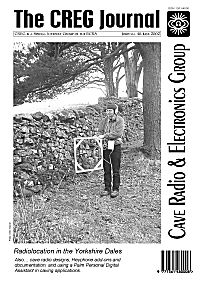
- The most recent issue to be published was 125
- For further information, please see Publishing/Despatch Schedule
- Database last updated on Wed, 03 Apr 2024 16:35:02 +0100
- Online access is currently available for all issues. Some of
the older issues are bit-map scans rather than digital copies.
journal scans.
- Online voting for CREG articles was withdrawn in June 2022. For info see
Voting for CREG articles
Contents of journal 48
June 2002
This page may take a few
seconds to load. Please wait ...
- CREG Journal
(PDF 4.7MB)
  Individual articles may be available below Individual articles may be available below
- Contents
-
- Newssheet
- Comment: CREG PCBs; Heyphone Documentation; Derbyshire CRO's 50th Year; Next Field Meet; Paying BCRA Subscriptions via CREG; Annual General Meeting, CREG Prize; Diary Dates.
-
- The March 2002 Field Meet
- This joint radiolocation event with the Cave Surveying Group was held in Ingleton. Richard Rushton and Rob Gill report.
-
- Trigonometric Radiolocation in a Plane
- Richard Rushton describes how making measurements at fixed points can allow us to locate radiolocation beacon by simple trigonometry, provided we are working in a single plane.
-
- Cave Radio Notebook
- 49: Trigonometric Radiolocation, 50: Finding Ground Zero (Peter Martinez). Edited by David Gibson.
-
- 3496Hz Radiolocation Beacon: Construction Update
- Brian Pease's beacon was described in the CREG journal in 1997. John Hey recently constructed two beacons to Brian's design, and relates his experiences.
-
- HeyPhone Documentation on the Web
- The HeyPhone documentation has now been updated with corrections and additional information. Mike Bedford indicates what you can now find on-line.
-
- HeyPhone System Update: Using Molefone Audio Equipment
- Many CROs are now re-equipping with HeyPhones, but there are some Molefone add-ons which may be worth converting for HeyPhone use. Chris Trayner explains Molefone audio equipment.
-
- Cave Surveying by Radio-Location - 3
- Cave radiolocation relies on magnetic fields and a crucial assumption is that these fields behave in a 'quasi-static' manner. David Gibson explains how the conductivity of the ground distorts the field lines, leading to error, and derives some new methods of eliminating these errors.
-
- A Tone-generator for Setting-up the HeyPhone
- For initial testing of the HeyPhone, rescue teams need to be able to compare signal strengths from different locations and with different antenna configurations. Mike Bedford describes an add-on tone generator which will permit this.
-
- A Field Strength Meter for the HeyPhone
- Mike Bedford describes an audio field strength meter which can be connected to the HeyPhone for set-up and testing.
-
- HeyPhone System Update: Powering External Equipment
- The Heyphone microphone socket can be used to power external equipment, but some versions require an adapter. Chris Trayner gives the details.
-
- Design Directory: Radiolocation and Cave Radio
- Under the classifications of 'building equipment', 'introductory articles', 'further reading' and 'historical reading', David Gibson lists some CREG journal articles that will give you some insight into the current state-of-the-art of radio-location beacons and cave communications using induction radio equipment.
-
- Flashgun Slave Unit for Digital Cameras
- Digital cameras often have a built-in flashgun that gives a small pre-flash in order to set the colour balance. A slave unit must respond to the second flash pulse. David Gibson describes how his slave unit can be adapted to achieve this.
-
- Bulb Firer Adaptor for Electronics Guns
- Flashbulb firers based on capacitor discharge circuits may damage, or be damaged by electronic flashguns. David Gibson describes a simple experimental adapter that allows a slave-driven bulb firer to be safely used with flashguns.
-
- Wet & Dry
- Laptop computers, GPS and PMR radio - Mike Bedford reviews examples of rugged and waterproof equipment.
-
- Letters to the Editor
- Early LED power controllers, DF Beacon Tests, PCB Design.
-
- Web Watch
- Peter Ludwig has found even more lighting and battery sites.
-
- Correction
- Jean-Jacques Fauchez, CREGJ 47.
-
- Palm Programming for Embedded Applications
- Electronic devices often require a user interface. This is frequently based on a microcontroller and an LCD module. Martin Melzer describes another approach, using a Personal Digital Assistant (or PDA) made by Palm, Inc.
-
- Meet the CREGgies (6)
- Rosy Rabson interviews Rob Gill, John Rabson and Jean-Jacques Fauchez.
-

|

View Contents:

BCRA is a UK registered charity and is a constituent body of
the British Caving Association,
undertaking charitable activities on behalf of the BCA.
BCRA publishes a range of periodicals and books.
Click here for further information.
|
Searching
To Search our pages using Google, type a search
string in the box at the top of the page and hit your Return key
You can also search our publications catalogue at the British Caving Library
The CREG Journal Search Engine is a new, powerful search engine which will, sometime, be extended
to cover Cave & Karst Science. We have a keyword search facility on our Cave Science Indexes pages but this may be rather out-of-date.
|
For staff use: Link to Database
Show/Hide
download figures next to each item (if available and non-zero; you might need to refresh page first). Counters last
reset on Thu 03-Jan-2019 17:29:28 +00:00. The figures are non-unique
click-throughs.
|








